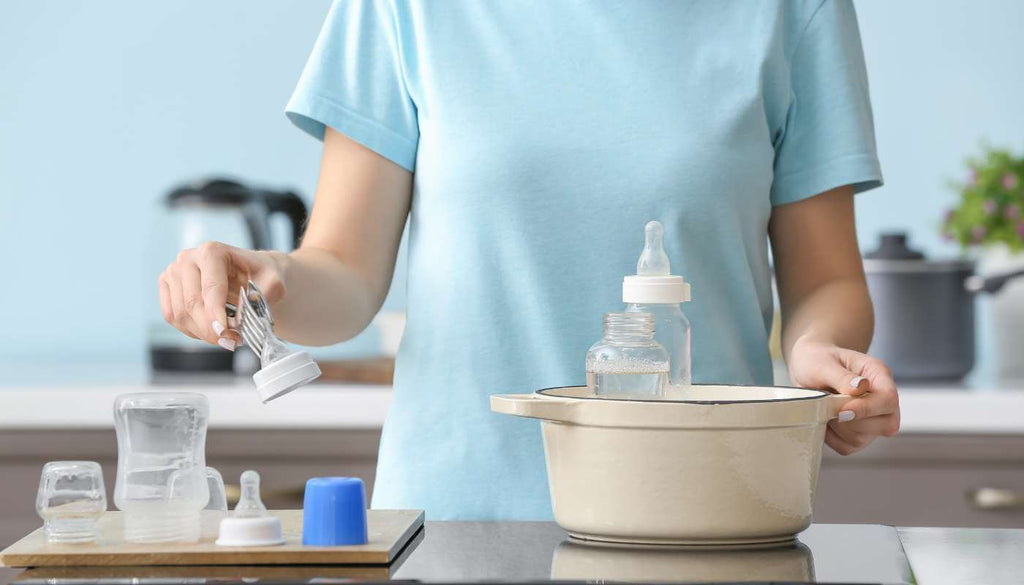
A Guide to Sterilising Baby Equipment
A Guide to Sterilising for Babies
One of the wonderful things about breastfeeding, if you can do it, is that you don’t need to worry about sterilising. You just whip out a boob and it’s breakfast time! If you’re not breastfeeding, or even if you are expressing to bottle feed, you will need to ensure that all your breastfeeding equipment is sterile, at least for the first six months of feeding. Although babies will develop immunity, for the first few months their immune systems are still getting up to full speed. Killing off any lurking bacteria will help prevent baby from developing illnesses like gastroenteritis which can cause vomiting, diarrhoea and dehydration – all of which can be dangerous for babies. Sterilising feeding equipment will help keep baby healthy.

What do you need for sterilising?
You'll need a bottle brush and dishwashing liquid. You’ll need to clean everything as soon as you can after baby has had a feed, or you’ve expressed using a breast pump. Once everything is clean, you can sterilise in a few different ways:
- Boiling
- Cold water with sterilisation chemicals
- Steam – electric or microwave
How to sterilise
You need to ensure that everything is properly clean before you can sterilise effectively. Putting unclean bottles or teats into the steriliser, whichever method you choose, won’t work properly if they’re not clean. This means washing all bottles, teats, dummies and parts of bottles and breast pumps. Wash them in hot water, with dishwashing liquid. It’s best to do this with a bottle brush, so you can get into every part of the bottle. The best bottle brushes have teat cleaners, so that you can get into all the awkward parts of the teats and round the tops of baby bottles effectively. Don’t forget to rinse all the dishwashing liquid off properly, by running everything under clean, hot water. It’s worth checking that you’re using an eco friendly dishwashing liquid that doesn’t contain ingredients such as triclosan.
Make sure that you wash your hands well before you sterilise baby feeding equipment, or making up a feed for baby.
Cold water sterilisation: this method uses chemical tablets containing bleach. Make sure that there is no air trapped in the bottles or teats, and immerse them completely in the solution. Generally, the sterilisation time is around 30 minutes. You’ll need to change the solution every 24 hours. My dislike with this method of sterilising is that the instructions say not to rinse the solution off before using the equipment. I didn’t want to leave chemicals on, so I preferred to use a couple of different methods.
Steam sterilising: electric or microwave steamers sterilise equipment, usually taking around 5-10 minutes, depending on what type you choose. You can also get microwave steriliser bags for on the go. Make sure that you follow the manufacturer’s instructions, as different devices are used in different ways. No chemicals required with this method, as the heat of the steam kills any bacteria.
Boiling: make sure that whatever you need to sterilise can be boiled. Just bring a large pot of water to the boil on the stovetop, and boil your equipment for 10 minutes. If you’re using latex teats or dummies, it’s worth noting that this method will mean that you need to replace them more often. It is a great way to sterilise glass bottles, however. As with steam sterilising, you don’t need to use any chemicals as the heat kills the bacteria.
How long do you need to go on sterilising for?
The advice on how to long to sterilise seems to differ according to which website you check. The Victorian Government recommends twelve. The British Government says six months is good, but twelve months if you’d prefer. Personally, I figured that by around six months, my babies were putting anything and everything into their mouths, so that was probably long enough. However, keeping all feeding equipment scrupulously clean is a no brainer, and if your baby has had any illnesses sterilisation is probably worth continuing until they are twelve months just to give their immune systems a helping hand.
Hints and Tips
There are small sterilisers for on the go, e.g. microwave steriliser bags and dummy sterilisers. These are very handy when you’re on the go or travelling with a young baby. If you’re out and about, it’s often worth taking a couple of extra dummies in a clean container so that you’re not without one if your baby drops it.




